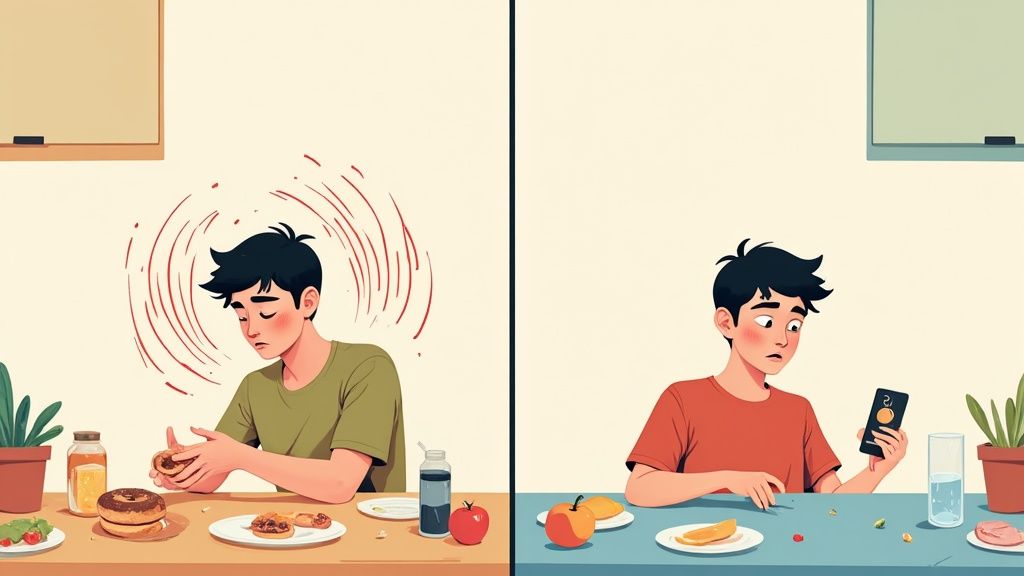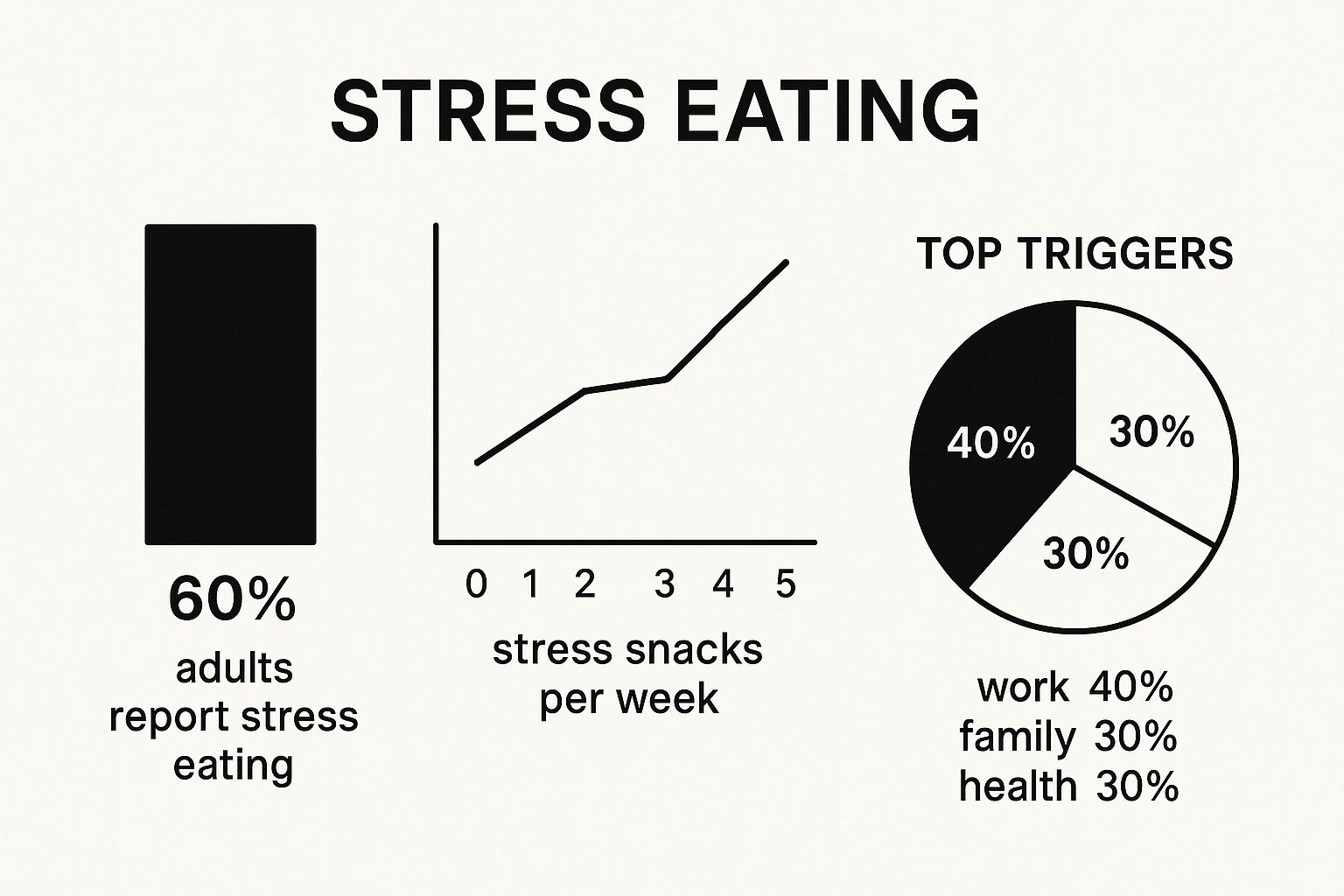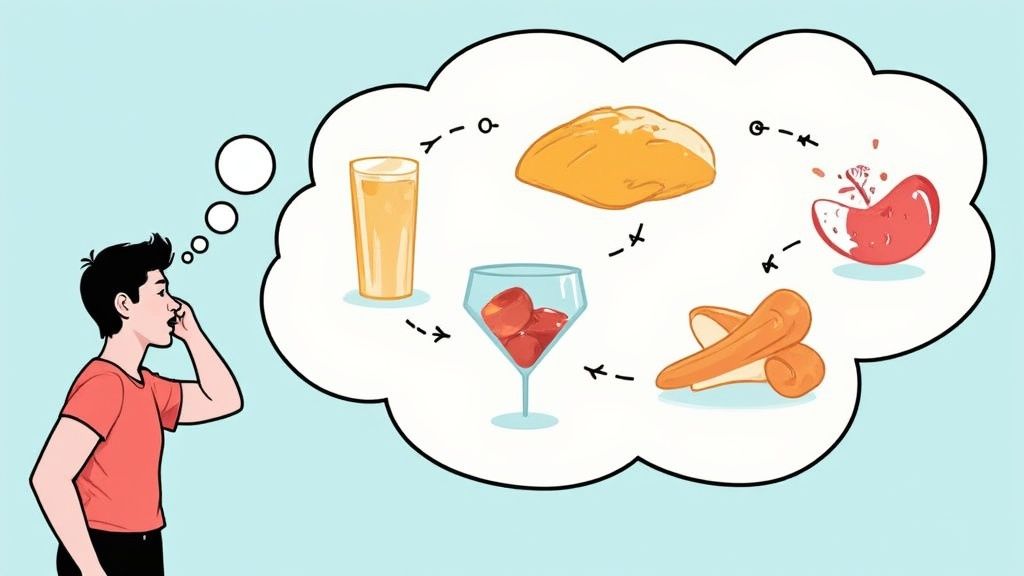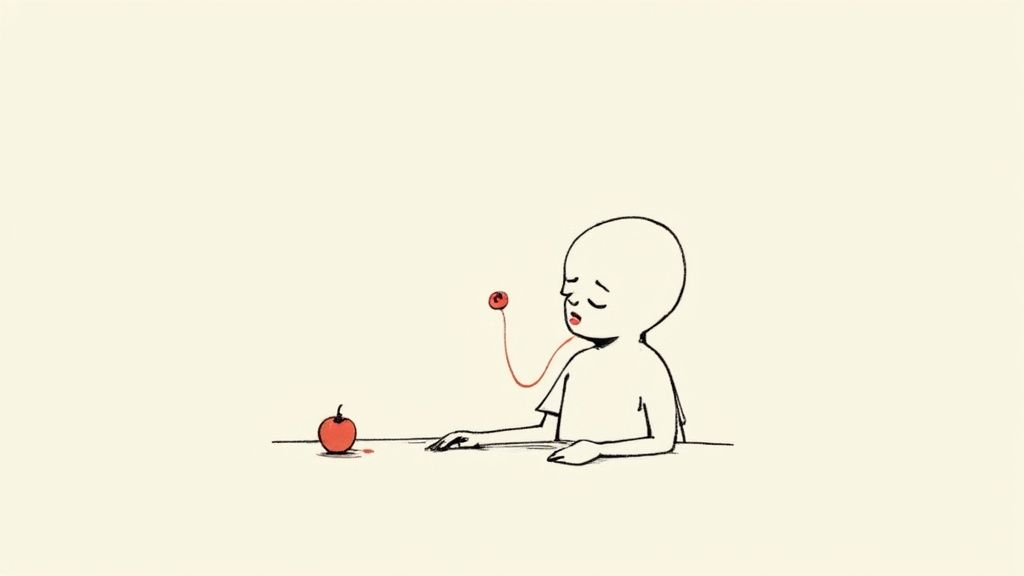How to Stop Stress Eating and Reclaim Your Health

To stop stress eating for good, you first need to understand why it happens. It’s not about willpower; it’s a biological response. Once you can pinpoint your personal triggers, you can start swapping the habit with healthier ways to cope and finally break the cycle.
Getting to the Root of Stress Eating
Have you ever found yourself mindlessly snacking after a draining day? You're not actually hungry, but you feel like you need something. That's a classic sign of stress eating, and trust me, you're not alone. It's a pattern driven by biology, not a lack of discipline.
When stress takes over, your body goes into defense mode and releases a hormone called cortisol, which can seriously ramp up your appetite.
This hormonal spike is what triggers those intense cravings for sugary, fatty, or salty foods. Our brains are hardwired to seek out these "comfort foods" because they deliver a quick, temporary hit of pleasure, making them an easy fix for difficult emotions. The problem is, that relief is fleeting and often replaced by guilt, trapping you in a frustrating cycle.
The numbers show just how common this is. For many, it's a weekly, or even daily, struggle.

As you can see, major life stressors like work and family are the biggest culprits, leading many people to reach for stress-related snacks an average of five times a week.
Physical Hunger vs. Emotional Hunger
The first real step to breaking free is learning to tell the difference between true physical hunger and its sneaky counterpart, emotional hunger. They show up in completely different ways. Paying close attention to the signals your body is sending is the key to regaining control.
Think of physical hunger as your body's legitimate request for fuel. It builds up gradually and can be satisfied by just about any food. Once you eat, you feel genuinely full and content.
Emotional hunger, on the other hand, hits you like a ton of bricks—it feels sudden and urgent. It almost always comes with a craving for a very specific type of food, like chocolate or pizza. The worst part? Even after you've eaten, you probably won't feel satisfied.
Being able to spot the difference in the moment is a game-changer. This quick table breaks down the main signs to look out for.
Physical Hunger vs Emotional Hunger At a Glance
| Symptom | Physical Hunger | Emotional Hunger (Stress Eating) |
|---|---|---|
| Onset | Comes on gradually over time. | Feels sudden and overwhelming. |
| Cravings | Open to different food options. | Craves a specific "comfort" food. |
| Location | Felt in the stomach (growling, pangs). | Felt as a "craving" in your head. |
| Mindfulness | You're aware of what and how much you're eating. | Often mindless, "zoning out" while eating. |
| Satisfaction | Stops when you feel full and content. | Can persist even when you're physically full. |
| Feelings Afterward | Neutral; you just feel satisfied. | Often leads to guilt, shame, or regret. |
Recognizing these patterns isn't a sign of weakness—it's your first major clue. When you can say, "Ah, this isn't real hunger, this is my stress talking," you've already started to take your power back.
The Big Realization: You can't fill an emotional void with food. Trying to do so only puts a band-aid on the symptom instead of addressing the real issue: the underlying stress.
This isn't just a hunch; it's a well-documented reality. A survey from the American Psychological Association found that nearly 40% of adults admitted to overeating or choosing unhealthy foods in the past month as a way to cope with stress. You can read more about the connection between stress and eating habits on Time.com.
Seeing this pattern in yourself is the first, and most important, step toward building a healthier response.
Figuring Out Your Personal Eating Triggers

Before you can change the habit of stress eating, you have to understand it. This means putting on your detective hat and getting curious about why you reach for food when you aren't truly hungry. Uncovering the patterns that link your feelings to your food choices is the single most powerful thing you can do.
The best way to start this investigation is with a simple 'Stress and Snack' journal. Don't overthink it—a basic notebook or even a notes app on your phone is all you need. The idea here isn't to judge yourself, but simply to gather data and observe what’s really going on.
Every time you feel that pull to eat under stress, just pause for a second. Take a moment to write down a few details. This simple act creates a tiny bit of space between the feeling and your reaction, and that space is where change begins.
What to Jot Down in Your Journal
To get a clear picture of what's happening, try to capture the context around each craving. This isn't about counting calories; it’s about understanding your personal story.
- The Time and Place: Do you find yourself wandering to the kitchen at 3 PM every day while working from home? Or is it late at night while you're scrolling on the couch? The setting is a huge clue.
- The Food You're Craving: Are you reaching for something crunchy and salty, like chips? Or is it sweet and creamy, like ice cream? Specific cravings can often point to specific emotional needs.
- How You're Really Feeling: Be brutally honest with yourself. Are you bored? Anxious? Overwhelmed by your to-do list? Maybe you're feeling lonely or just procrastinating on a task you dread. Give the feeling a name.
- What Just Happened: This is often the smoking gun. Did you just hang up from a tense call with your mom? Did a passive-aggressive email from your boss land in your inbox? Did you have a fight with your partner?
Here's the key: This whole process isn't about shaming yourself for eating. It's about gathering intelligence. Think of each journal entry as a puzzle piece. Once you have enough pieces, you can put them together and see the bigger picture of what's driving your actions.
You might start to notice things you never saw before. For instance, maybe you’ll realize that every time you feel overwhelmed by a project deadline, you find yourself at the vending machine. Or you might discover that Sunday afternoon boredom is a reliable trigger for reaching for the cookie jar.
Connecting the Dots to See Your Triggers
After keeping this journal for a week or two, the patterns will start to jump out at you. It will become impossible to ignore the direct line connecting a specific stressor to a specific eating behavior. These are your personal triggers.
Just recognizing them is incredibly empowering. Why? Because you can't change a habit you're not aware of. This newfound awareness is the bedrock for building healthier ways to cope. It’s a crucial part of learning how to stop emotional eating because it helps you shift your focus from the food to the real issue.
Instead of just battling the urge to eat, you can start asking, "What do I actually need right now?" and address the feeling head-on.
Building Your Toolkit of Healthy Coping Skills
Once you know what sets you off, the real work begins: building a solid toolkit of healthier ways to respond. Think of it less like a strict diet rulebook and more like your own personal menu of non-food strategies you can pull from the second an emotional craving hits. This isn't about white-knuckling it through a craving; it's about having better, more effective options ready to go.
The whole point is to have a go-to list of actions that make the healthy choice feel easier than grabbing a snack. Trying to invent a new coping mechanism when you're already stressed is a recipe for failure. You need these alternatives locked and loaded before the pressure builds.
This link between our minds and our eating habits is no joke. A 2020 survey found that 83% of adults grapple with moderate to severe stress, which often leads directly to emotional eating. You can see the full study and its insights on mental health correlations for yourself. The trick is finding a strategy that actually soothes the real feeling, not just the symptom of wanting to eat.
Coping Skills for High-Energy Stress
What about when you’re buzzing with anxiety, anger, or just pure restlessness? Your body is flooded with nervous energy, and that powerful urge to eat is often just your brain's clumsy attempt to channel that frantic feeling. Instead of eating, give that energy a proper outlet.
- Move Your Body: This doesn't have to be an hour-long gym session. A brisk 10-minute walk around the block can work wonders to clear your head.
- Dance It Out: Seriously. Put on your favorite upbeat song and just let loose for a few minutes. It might sound silly, but it's an incredibly fast and effective way to shift your entire mood.
- Quick Strength Burst: Drop and do a set of push-ups, some quick bodyweight squats, or even jumping jacks. It interrupts the stress cycle and gives you a quick win.
These physical actions help your body metabolize stress hormones like cortisol and adrenaline, giving you the release you were actually looking for in the first place.
Strategies for Low-Energy Stress
Sometimes stress isn’t frantic. It’s heavy. It shows up as sadness, loneliness, or just crushing boredom. In these moments, you're not looking for a release; you're looking for comfort, connection, or simple distraction. Food is an easy, temporary fix, but there are far better ways to find what you truly need.
Your Toolkit Takeaway: The most effective coping skill is one that directly answers the emotion you're feeling. If you're bored, find something that engages you. If you're lonely, connect with someone. If you're anxious, find a way to genuinely soothe yourself.
Here are a few ideas to get you started:
- Engage Your Mind: Get lost in a good story. Put on an absorbing podcast or an audiobook. It’s a fantastic way to pull yourself out of a negative thought spiral.
- Reach Out for Connection: A quick text or a five-minute call to a friend or family member can be a powerful reminder that you aren't alone. It’s a simple action that delivers a real emotional boost.
- Get Creative: Spend a few minutes on a hobby. Doodle in a notebook, play an instrument, or even just organize one drawer. Giving your mind a positive, creative task to focus on is a game-changer.
Putting this toolkit together is all about trial and error. Be patient with yourself. Experiment with different things and pay attention to what actually makes you feel better. The more you practice reaching for these alternatives, the weaker that old, automatic link between stress and eating will become.
Change Your Relationship with Food: Mindfulness and Smart Swaps

Now that you have some healthier coping skills in your back pocket, it's time to work on your direct relationship with food. Let's be real—even with the best intentions, there will be moments when you still find yourself reaching for something to eat out of habit or stress. The goal here isn't to stop that completely, but to make those moments less damaging and a lot more intentional.
We'll do this with a two-part strategy: practicing mindful eating and making smart food substitutions. This isn't about forbidding certain foods. It's about changing how you eat them.
Tune In with the Five-Senses Check-In
Mindful eating is simply the practice of being fully present with your food. It sounds simple, but it's incredibly powerful for reconnecting with your body’s actual hunger and fullness signals. It can turn a rushed, thoughtless act into a genuinely satisfying experience.
A fantastic way to start is with a 'five-senses check-in' right before you take your first bite. Before you eat, just pause for 30 seconds and engage all your senses. This small action can dramatically slow you down and boost your satisfaction.
- Sight: Really look at your food. What colors and shapes do you see on your plate?
- Smell: Take a deep breath. What aromas do you pick up? Sweet, savory, earthy?
- Touch: Notice the texture of the food with your fork or fingers. Feel its temperature.
- Sound: What sounds does your food make? The crunch, the sizzle, the fizz?
- Taste: Finally, take that first bite and just savor it. Try to pick out all the different flavors.
This little exercise grounds you in the moment, helping you get more pleasure from less food and putting the brakes on mindless overeating. For a deeper dive, check out our complete guide to powerful mindful eating exercises.
Make Smarter Swaps When Cravings Hit
The other half of the strategy is making smarter choices when a craving feels too strong to ignore. Remember, this is about substitution, not deprivation. By having healthier alternatives ready to go, you can ride out a stress-eating wave without completely derailing your progress.
The trick is to find swaps that give you the texture or taste you’re really after, just in a healthier form.
Progress Over Perfection: The goal is never to be perfect. It’s about making a slightly better choice in a tough moment. Swapping a bag of greasy potato chips for some air-popped popcorn? That's a huge win.
Here are a few common cravings and some easy, smarter swaps:
| If You're Craving This... | Try This Instead... | Why It Works |
|---|---|---|
| A Candy Bar | A square of dark chocolate (70% cocoa or higher) with a few almonds. | You get that sweet hit and satisfying crunch, plus some fiber and healthy fats. |
| A Bag of Chips | Air-popped popcorn seasoned with nutritional yeast and a pinch of salt. | It satisfies that need for something salty and crunchy for way fewer calories and fat. |
| Ice Cream | A bowl of Greek yogurt topped with frozen berries and a tiny drizzle of honey. | This delivers the creamy, sweet comfort you want with a great boost of protein and antioxidants. |
When you combine mindfulness with these practical swaps, you create a powerful defense against stress eating. You learn to appreciate your food more deeply while also softening the blow when those inevitable cravings strike.
Creating a Supportive Home Environment

Let’s be honest: willpower is a finite resource. On a good day, it's easy to say no to that pint of ice cream. But on a tough day, when stress is high and your energy is low, relying on sheer willpower is a losing battle. Lasting change happens when your environment isn't actively working against you.
This is where we can borrow a powerful concept called choice architecture. It's just a fancy way of saying you intentionally set up your surroundings to make the best choices the easiest ones. If junk food is the first thing you see when you open the pantry, you're making things unnecessarily hard on yourself.
Think about it. The simplest way to not eat an entire bag of chips when you're stressed is to not have it in the house to begin with.
Curate Your Kitchen for Success
Your kitchen should be your command center for building better habits, not a minefield of temptations. A few small, strategic tweaks here can make an enormous difference in your day-to-day success.
- Out of Sight, Out of Mind: If you have to keep trigger foods around for other family members, make them inconvenient. Put them on a high shelf, in the back of the pantry, or inside an opaque container.
- Promote the Good Stuff: Make healthy choices the path of least resistance. Keep a big bowl of fresh fruit on the counter. Have pre-cut veggies and hummus right at eye level in the fridge. When a craving hits, you want the healthiest option to be the most visible and easiest to grab.
This isn't about deprivation. It's about setting yourself up to win by making your home an ally in your journey.
My Takeaway: You're essentially redesigning your space to do the heavy lifting for you. When a healthy choice is more convenient than an unhealthy one, you conserve the mental energy you desperately need when you're feeling stressed and vulnerable.
Build Your Support System
You absolutely do not have to do this alone. In fact, going it solo can make the process feel isolating and much more difficult. One of the most important steps is to let your close friends and family in on what you're doing.
Explain your goals and be specific about how they can support you. It might be as simple as asking them not to offer you your biggest trigger food, or suggesting a walk to de-stress together instead of grabbing dessert.
It helps to remember just how common this is. A 2023 study revealed that nearly 31% of adults turn to food to manage stress and anxiety. The research also showed that relaxation techniques and a supportive environment are critical for breaking the cycle. If you're curious, you can read more about these stress eating findings and see the science behind it.
Solidify Your Self-Care Foundation
Finally, a truly supportive environment includes your daily routines. Your best defense against stress is a solid foundation of self-care. It sounds simple, but prioritizing things like getting enough sleep and moving your body regularly builds incredible resilience.
When you're well-rested and physically active, your body is just better at handling life's curveballs without sounding the alarm for a quick-fix from food. These small, consistent habits create a powerful buffer, making you far less likely to fall into an emotional eating pattern in the first place.
Common Questions About Overcoming Stress Eating
As you start to untangle your relationship with food, it's totally normal for questions and a few challenges to pop up. This whole process is about making steady progress, not being perfect. Having a game plan for those tough moments is what makes all the difference. Here are some of the most common things people wonder about as they learn to stop stress eating.
What if I Slip Up and Stress Eat?
First things first: take a deep breath. Let go of the guilt. One slip-up doesn't undo all the hard work you've put in. What really matters is what you do next. Instead of letting a moment of weakness spiral into a cycle of shame and more eating, look at it as a learning experience.
Ask yourself, "What just happened here?" Maybe it was a new trigger you hadn't recognized before. Perhaps you were more exhausted or overwhelmed than you realized. This isn't about placing blame; it's about gathering clues for the future. The real goal is to simply get back on track with your very next choice.
Key Takeaway: A slip-up isn't a failure—it's feedback. Use it to understand your patterns, treat yourself with kindness, and then refocus on your goals. The all-or-nothing mindset is your biggest hurdle.
How Long Does It Actually Take to Stop Stress Eating?
This is such a personal journey, so there’s no universal timeline. Breaking a deeply ingrained habit like turning to food for comfort takes time and consistent effort. It's less about crossing some imaginary finish line and more about building a new, healthier set of go-to responses when stress hits.
You might start noticing real progress within a few weeks as your awareness grows. But making these new habits feel automatic can take several months, or sometimes even longer. Be patient with yourself. Celebrate the small wins—like that one time you chose to take a walk instead of opening the pantry. Every single one of those small victories helps build stronger, healthier pathways in your brain.
When Should I Think About Getting Professional Help?
Self-help strategies and tools are incredibly powerful, but sometimes, a little extra support is needed. Recognizing when you need help isn't a sign of weakness; it's a sign of strength and self-awareness.
It might be time to reach out to a professional if:
- Your eating habits are causing you a lot of distress or getting in the way of your work, relationships, or daily life.
- You find yourself binging, purging, or engaging in other restrictive patterns.
- You feel like your emotional eating is out of control, no matter what you try.
- You think there might be something else going on, like depression, anxiety, or a potential eating disorder.
A registered dietitian can help you sort out the nutrition side of things, while a good therapist can help you dig into the deeper emotional reasons behind your stress eating. They offer structured support that's designed just for you. You don’t have to figure this all out by yourself. Learning how to handle specific urges, like when you want to avoid sugar cravings, is a skill, and sometimes a coach or professional is the best person to teach you.